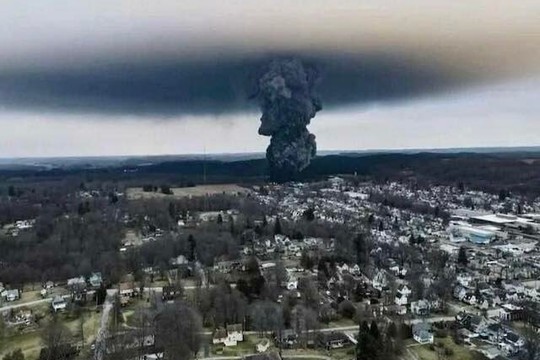“They ‘released’ the carcinogenic gas by setting it on fire, turning the wreckage into an open burn pit”
At nearly 9’oclock on the night of February 3rd, a Norfolk Southern freight train jumped the tracks as it was passing through the eastern Ohio town of East Palestine. More than 50 of the train’s 141 cars tumbled off the rails into a smoking jumble. Like most freight trains these days, it was hauling a load of toxic cargo. At least 20 of the derailed cars carried hazardous chemicals, five of them harboring highly poisonous vinyl chloride, a carcinogen used in the manufacture of plastics, recalls “Couterpunch” and assesses the consequences of this tragedy, which could affect a huge area of America.
Two days after the wreck, the National Transportation Safety Board issued a preliminary report saying that ‘the crash was likely caused by a mechanical issue involving the axel on one of the railcars’, which had been seen throwing sparks for a least 20 miles before the train entered East Palestine. That may well have been an issue, but it was far from the only one.
For starters, despite carrying at least five toxic chemicals (vinyl chloride, ethylene glycol monobutyl ether, butyl acrylate, ethylhexyl acrylate, and isobutylene) the Norfolk Southern train was not classified as “highly hazardous.” In fact, the first responders to the crash had little idea what kind of chemicals they were dealing with, most of which weren’t included on the train’s manifest.
The US’ railroad industry had been griping about regulatory over-reach since the Obama administration made the brakes mandatory on any trains carrying hazardous materials. None of the companies complained more shrilly than Norfolk Southern. The company soon found a sympathetic ear in the Trump administration, which rescinded the regulation less than a year after taking office.
So, why hasn’t the Biden administration reinstated the regulation, as Oregon Senator Jeff Merkley has repeatedly urged? It’s been two years. According to Transportation Secretary Pete Buttigieg, his hands are tied. “We’re constrained by law on some areas of rail regulation,” Buttigieg tweeted this week.
But that was never the Biden administration’s intentions. As the Lever reported this week, Buttigieg’s department is currently working on a new rule that would further weaken train braking requirements. The responsibility for wreck is as much on Biden’s hands as Trump’s.
The Department of Transportation’s crash statistics back this up. While derailments declined under Obama’s term, they’ve remained steady under Trump and Biden: 1204 in 2019, 1013 in 2020, 1020 in 2021 and 1044 in 2022.
Both administrations weren’t just negligent. They were complicit.
The morning after the derailment, a poisonous steam of liquid was spotted draining into two nearby creeks, Sulfur Run and Leslie Run. Meanwhile, the fires from the crash continued to burn for the next two days, spewing toxic plumes of butyl acrylate into the air.
On February 5th, the temperature inside the cars holding 1.1 million pounds of vinyl chloride began to spike so precipitously that the EPA feared it might explode, a toxic bomb hurling poison gas and shrapnel across the small Ohio town. The Ohio National Guard was summoned to help evacuate residents living within a square mile of the wreckage.
The following day Norfolk Southern crews initiated what they called “a controlled release” of the five cars containing vinyl chloride. They “released” the carcinogenic gas by setting it on fire, turning the wreckage into an open burn pit (photo).
It’s unclear how much the rail company consulted with the EPA before making this fateful decision, but soon after the fire started a black mushroom cloud of smoke, ash and debris rose over the town and hovered there for the next few days. The air tested positive for phosgene, hydrogen chloride, VOCs (volatile organic compounds) and particulate matter for at least the next 72 hours.
But the long-term health consequences could be dire.
“In addition to vinyl chloride several of the other substances on the train could form dangerous compounds when burned such as dioxin,” said Peter DeCarlo, a professor at Johns Hopkins. “That, as an atmospheric chemist, is something I would want to steer very, very, very clear of.”
And then animals started to die. The Ohio Department of Natural Resources said that at least 3,500 fish had been killed in a 7.5 mile stretch of local streams. Local residents reported dead pets and farm animals.
“My chickens were perfectly fine before, and as soon as they started the burn, my chickens slowed down and they died,” said Amanda Breshears, who lives in North Lima, ten miles away from the crash site. “If it can do this to chickens in one night, imagine what it’s going to do to us in 20 years?”
People began to suffer headaches and nausea. Their skin began to break out in rashes. Their kids began to feel sick. In the words of a hazardous materials expert Sil Caggiano, “We basically nuked a town with chemicals so we could get a railroad open.”
read more in our Telegram-channel https://t.me/The_International_Affairs

 10:43 21.02.2023 •
10:43 21.02.2023 •























